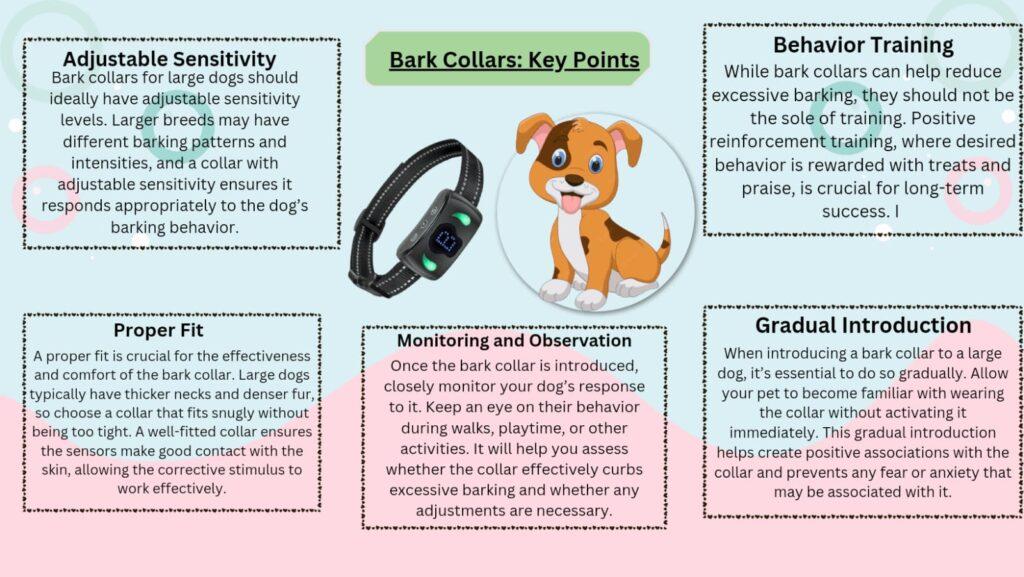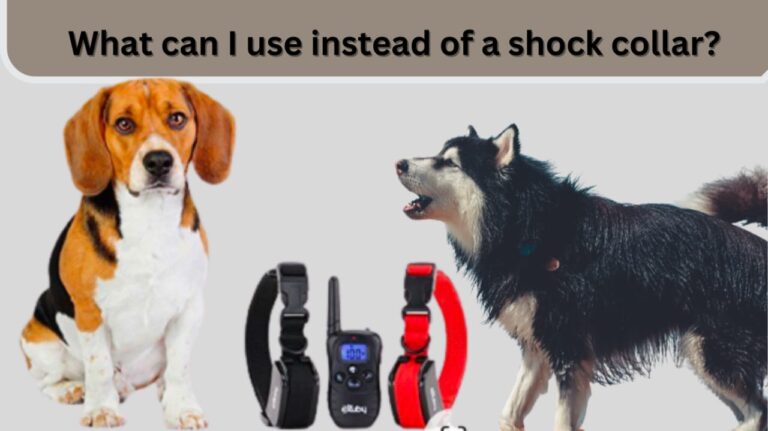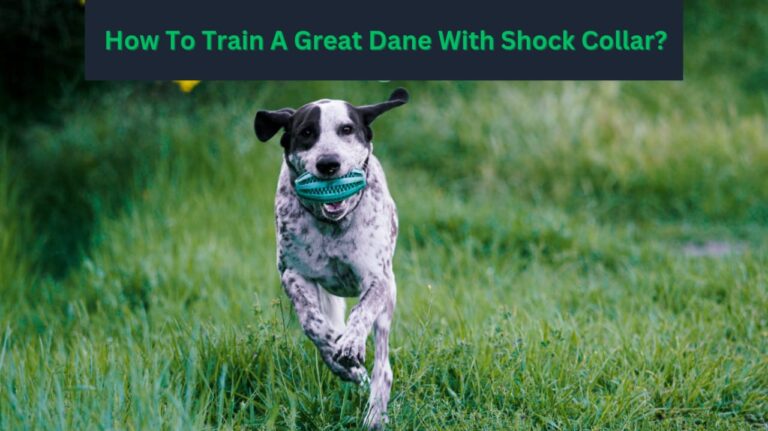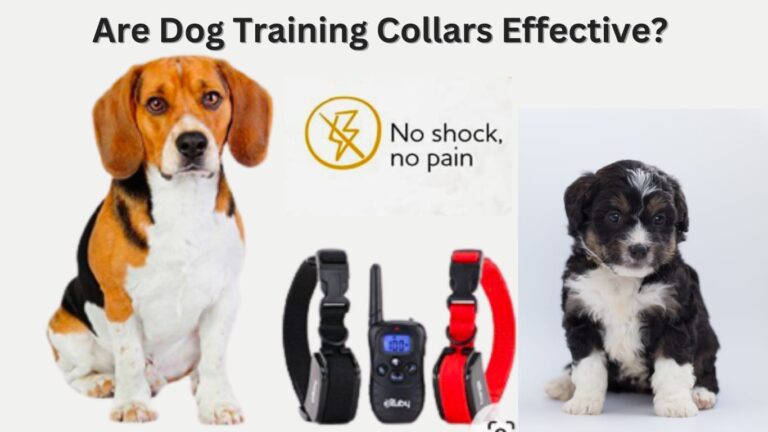Do Bark Collars Work On Large Dogs?

Do bark collars work on large dogs?
Large dogs often have loud barks, which create challenging situations for their owners. Many dog owners who have large dogs who bark loudly and know about bark collars called anti-bark collars are unsure whether Do bark collars work on large dogs? Are they safe? How do bark collars work? Then the answer is yes the only solution is to use a dog bark collar for your large dog that is specially designed for larger breeds.
Barking dogs can sometimes create tension with neighbors, especially if they have young children or families who value a peaceful environment. Large dogs with powerful barks can be disruptive and disturb nearby households, especially at night when everyone is trying to sleep.
It may be possible to address the barking problem by using a bark collar on a large dog in such cases.
Do bark collars work on large dogs? Let’s find out.
Bark collars can be effective on large dogs, but their success depends on several factors. Large dogs often have louder and deeper barks, and their behavior can differ from smaller breeds. When considering using bark collars on larger dogs, it’s necessary to keep the following points in mind:

Adjustable Sensitivity Levels:
Bark collars for larger dogs, including those designed for big breeds, are most effective when they have adjustable sensitivity levels. This feature ensures the collar responds appropriately to the unique barking behaviors and intensities often seen in larger dogs.
Proper Fit for Comfort:
Getting the right fit for a bark collar is crucial for both comfort and effectiveness. Larger dogs, with their thicker necks and denser fur, benefit from a snug fit that isn’t too tight. This is important to ensure the collar’s sensors make good contact with the skin for effective correction.
Balanced Training Approach:
While bark collars, like anti-bark collars, can help reduce excessive barking, it’s important not to rely solely on them for training. Positive reinforcement, such as rewarding good behavior with treats and praise, plays a crucial role in long-term success and behavior modification.
Gradual Introduction for Positive Association:
Introducing a bark collar to a larger dog should be a gradual process. Allowing your dog to become familiar with wearing the collar without immediate activation helps create positive associations. Start with short periods, gradually increasing the duration as your dog becomes more comfortable.
Continuous Monitoring for Optimal Results:
Once the bark collar, suited for larger dogs, is introduced, keep a close eye on your dog’s response. Observe their behavior during walks, playtime, and various activities to assess the collar’s effectiveness in curbing excessive barking. Regular monitoring allows for adjustments, ensuring the best results in training.

How do bark collars work on large dogs?
Let’s find out how these bark collars work to reduce excessive barking in dogs.
Bark collars for large dogs are designed to address excessive barking behavior. These collars detect barking through built-in sensors and deliver a corrective stimulus, such as a mild static sensation, ultrasonic sound, spray, or vibrating the dog barks. The goal is to interrupt the barking pattern and discourage further excessive barking. The collar’s effectiveness is enhanced by features like adjustable sensitivity levels and a proper fit for optimal responsiveness and comfort for the large dog.
The anti-bark collar works if you use it properly, so decide how much time you will devote to teaching your dog constantly before you begin training.
In training a dog, there are some key points you need to keep in mind.
- Use the anti-bark collar consistently to reinforce the training. Regular and consistent use will help the dog associate barking with the corrective stimulus.
- Introduce the anti-bark collar slowly to your dog. Allow to get accustomed to wearing the collar without activating it immediately. This gradual introduction helps create positive associations with the collar.
- Pair the anti-bark collar with positive reinforcement techniques, such as treats and praise, to encourage desired behavior. This positive approach reinforces good behavior.
- Monitor your dog’s response to the anti-bark collar during training. Observe behavior necessary adjustments to the collar’s sensitivity or fit to ensure effectiveness and comfort.
- Training takes time and patience. Be patient with your dog’s progress and understanding of the learning process. Avoid punishment and focus on positive reinforcement to achieve the best results.
How long does a bark collar take to work?
Well, the effectiveness of bark collars, including those designed for large dogs, can vary based on different factors. These collars, also known as anti-bark collars or dog bark collars, are designed to address excessive barking behaviors. The timeline for noticeable results depends on individual dogs, the consistency of collar use, and the specific type of collar, including the no-bark collar.
When it comes to larger breeds, finding the right fit is crucial. That’s why there are specialized bark collars for big dogs and dog bark collars for large dogs. These collars are crafted to cater to the unique needs of larger canines, providing both comfort and effectiveness during training sessions.
It’s important to note that while some dogs may respond to bark collars within a few days, others might require a more extended training period. In conclusion, the timeline for a bark collar to work depends on factors like your dog’s temperament, the reason for barking, and the collar type. Consistent and humane use, especially with collars designed for larger dogs, can help in effectively curbing excessive barking behavior over time.
Is a bark collar safe?
Many dog owners are worried and want to know whether anti-bark collars are safe or not for their dogs.
As a responsible dog owner, I want to emphasize that bark collars can be safe if used correctly. When using bark collars for your dog, select one that fits your dog’s size and temperament. Proper fitting is crucial to avoid any discomfort or potential harm to your

How to use a dog barking collar humanely?
If you are seeking humane ways to use a bark collar for your large dog, look no further, The key lies in selecting a collar that suits your dog’s size and temperament, ensuring a comfortable fit. Gradual introduction and positive reinforcement techniques will help your dog adjust to the collar without distress.
Always follow the manufacturer’s instructions and avoid leaving the collar on for extended periods. Remember, a bark collar should be part of comprehensive training complemented with love, patience, and attention to your dog’s well-being. For further guidance on using bark collars humanely, consult a professional dog trainer or veterinarian who can provide expert advice and support. Together, we can ensure our pets’ happiness and comfort while effectively curbing excessive barking.
Different types of bark collars
Bark collars are devices designed to address excessive barking in the canine. There are three different types of bark collars available in the market.
- Citronella dog collar
- Ultrasonic dog collar
- Static shock collar
Citronella dog collar
Citronella dog collars have gained popularity as a humane and effective solution for managing excessive barking in pets. Unlike traditional bark collars that may use static stimulation, citronella collars offer a more gentle and natural approach.
Bark collars, including dog bark collars and anti-bark collars, are designed to address barking behavior. The distinctive feature of a citronella collar is its use of citronella spray as a deterrent. When the dog barks, the collar releases a burst of citronella, which dogs find unpleasant but is entirely harmless.
The key advantage of a citronella dog collar is its focus on positive reinforcement. Instead of using punitive measures, the collar interrupts the unwanted behavior with a mild, scented deterrent. This creates an association for the dog between barking and the citronella scent, encouraging them to refrain from excessive vocalization.
For pet owners seeking an alternative to electric shocks or vibrations, the no bark collar with citronella can be a suitable choice. It offers a more natural and less intrusive method for training, catering to the well-being of both the pet and the owner.
It’s important to note that while citronella collars can be effective for many dogs, individual responses may vary. Consistent and proper use, along with positive reinforcement, enhances the likelihood of success in reducing unwanted barking.
Ultrasonic dog collar
Ultrasonic dog collars have emerged as an innovative and humane solution to address the challenge of excessive barking in pets, including large dogs. Unlike traditional bark collars that utilize various deterrents such as static stimulation or citronella spray, ultrasonic collars employ a technology that is virtually silent to human ears.
Bark collars, including dog bark collars and anti-bark collars, are designed to modify barking behavior. The ultrasonic collar is equipped with a small device that emits a high-pitched sound when triggered by a dog’s bark. This ultrasonic sound is unpleasant for the dog but is generally unnoticed by humans, making it an inconspicuous and effective solution.
One of the key advantages of an ultrasonic dog collar is its gentle and non-intrusive nature, making it suitable for large dogs. It offers a way to deter excessive barking without the use of physical stimuli or scents. This makes it a suitable alternative for pet owners who prefer a more subtle approach to bark control for their large canine companions.
In comparison to traditional no bark collars, the ultrasonic version is often preferred for its quiet operation. It provides a discreet and efficient way to discourage barking, particularly in situations where constant noise from barking can be disruptive.
It’s essential for pet owners to understand that while ultrasonic collars can be effective for many dogs, individual responses may vary. Consistent and proper use, as well as positive reinforcement, can contribute to successful training in reducing unwanted barking.
Static shock collar
The static shock collar, often included in the category of bark collars, is a device designed to address excessive barking in dogs. While it’s considered an option among various bark control methods, it’s essential for pet owners to weigh the potential benefits against ethical considerations.
Bark collars, including dog bark collars and anti-bark collars, come in various types, and the static shock collar is one of them. Specifically designed for dogs, including large breeds, these collars are equipped with a mechanism that delivers a mild static shock when the dog barks excessively.
The static shock is intended to interrupt the barking behavior and act as a deterrent. However, opinions on the use of static shock collars are divided. Some argue that when used appropriately, these collars can effectively curb unwanted barking. Others express concerns about the potential for discomfort or stress in dogs, leading to ethical considerations.
For pet owners considering a static shock collar, particularly for large dogs, it’s crucial to research and understand the proper usage. These collars should be fitted correctly to ensure the electrodes make good contact with the dog’s skin. Additionally, they should only be used in specific situations and not as a continuous form of punishment.
No bark collars, which include various types like the static shock collar, aim to provide a solution to excessive barking. However, it’s recommended to explore other alternatives, such as positive reinforcement training, before resorting to methods that may involve aversive stimuli.

Conclusion
In conclusion, “Do bark collars work on large dogs?” can be answered confidently with a “yes.” These collars can be practical tools to help address excessive barking in larger breeds, provided they are used responsibly and alongside proper training methods. Bark collars can work on large dogs if appropriately used. Choose a collar that fits well and can adjust to your dog’s needs. Introduce the collar gradually and use positive reinforcement during training. Always prioritize safety and follow the collar’s instructions. There are different types of bark collars, such as citronella, ultrasonic, and static shock collars. Combining bark collars with other training methods can help reduce excessive barking in large dogs and create a more peaceful environment.
You can also read this: Are No Bark Collars Cruel?
What Can I Use Instead Of A Shock Collar?
What Does A Training Dog Collar Do?
6 Best Anti-Bark Collars For Large Dogs 2023
FAQ
How long does it take a bark collar to work?
The time it takes for a bark collar to work can vary from dog to dog. Some dogs may show improvement in their barking behavior within a few days, while others may take a few weeks. Consistent and proper use of the collar, along with positive reinforcement training, can contribute to faster and more effective results.
How long can you leave a bark collar on a dog?
You should not leave a bark collar on a dog for more than 8 hours at a time. Giving your dog breaks from wearing the collar is essential to prevent any potential discomfort or skin irritation. Always follow the manufacturer's guidelines and use the collar responsibly to ensure your dog's safety and comfort.
When should you not use a bark collar?
You should not use a bark collar on a scared or anxious dog. Don't rely solely on the collar if your dog's barking is caused by other problems. Avoid using it if your dog is very young, very old, or has health issues.
How do I choose an anti bark collar?
To choose an anti-bark collar, consider your dog's size and temperament. Opt for a collar with adjustable settings and humane correction methods. Seek professional advice for the most suitable option for your dog's specific barking behavior.





